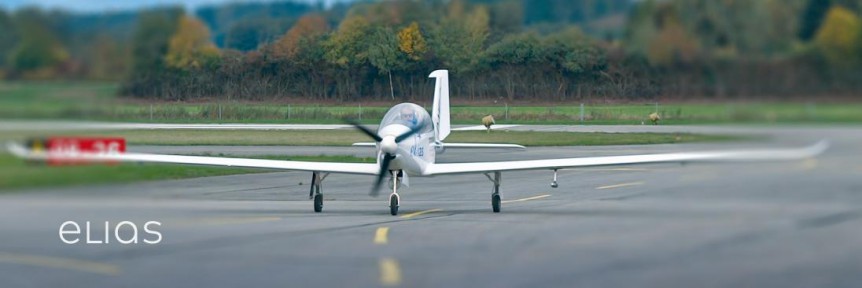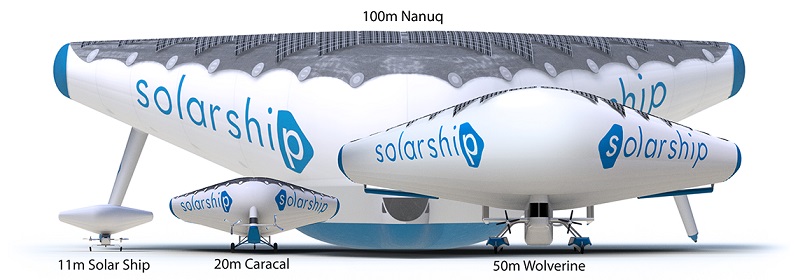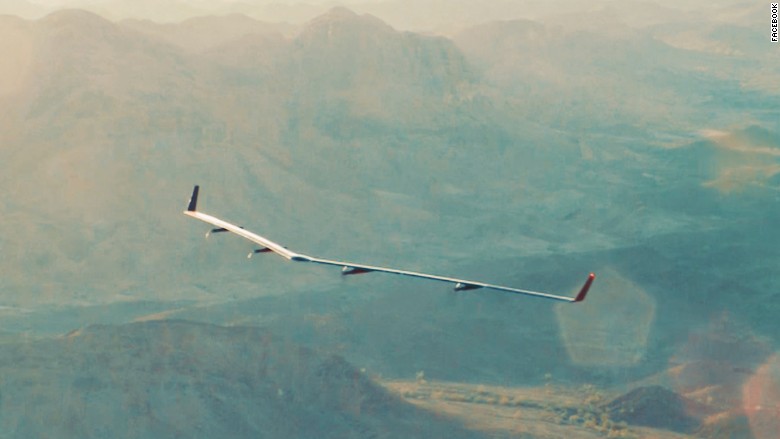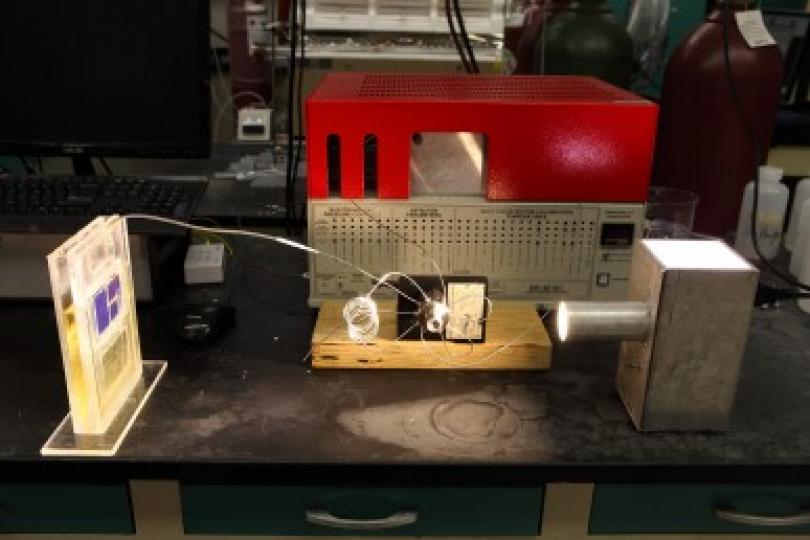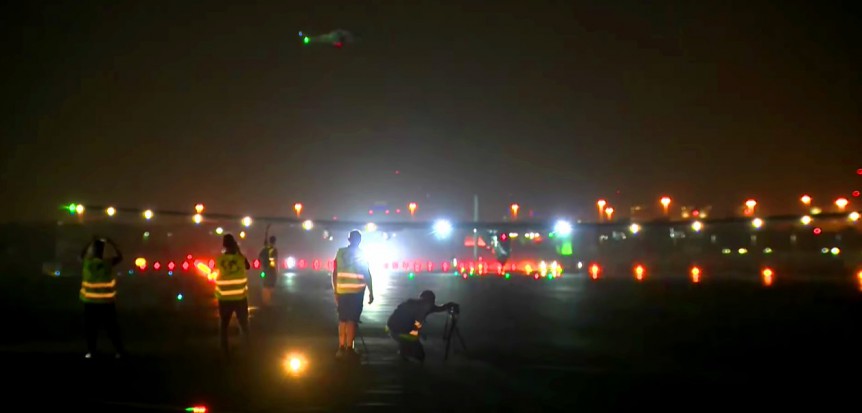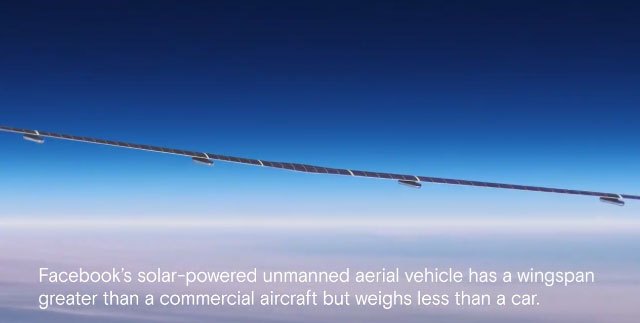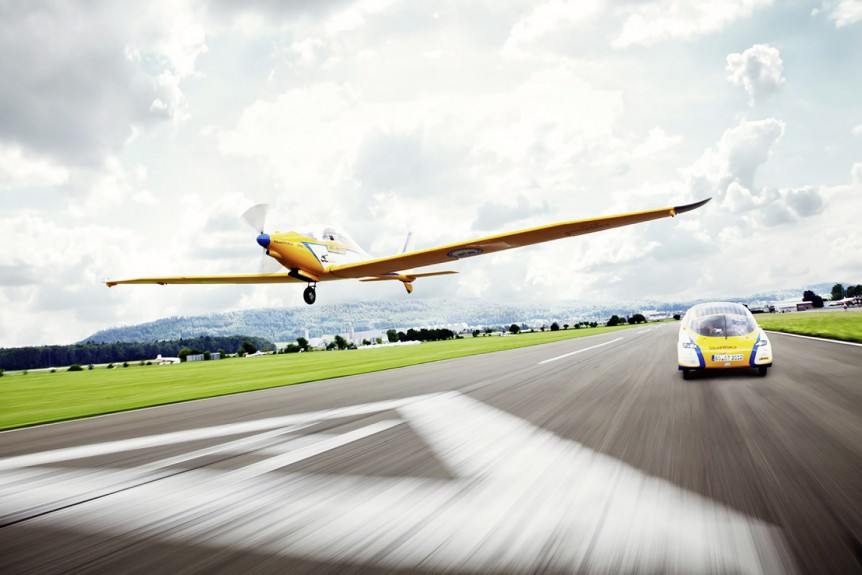Raphael Domjan is an adventurer in every sense of the word. He’s sailed around the world on solar power, and attempted to paddle his way across the Northwest Passage in a solar-powered kayak. And now, he’s revealed an airplane that could carry him to the stratosphere on solar power. SolarStratos is a 24.9-meter (81.7 feet) span motorglider shown to the public for the first time yesterday in Payerne, Switzerland. With stage smoke and rock-concert lighting glittering from the solar cells on its wings and tail, the Calin Gologan-designed craft materialized before the crowd of 400 (according to Calin) gathered in the specially-built hangar. At a loaded weight of only 450 kilograms (990 pounds), SolarStratos should climb well on its dual motor, a mere 19 pounds itself. A planned flight time of approximately five hours to take pilot and passenger to the planned 75,000 foot, near-space experience. On only 42.8 horsepower swinging a 2.2-meter (7.2-feet), four-bladed propeller, this is, outside of the …
Acentiss Electric Dual-Rotor Aviation Motor
Acentiss is a German engineering and consulting firm specializing in medicine, aerodynamics, and recently, the creation of two small electric motors for light aircraft. Located almost symbolically between Robert Koch Strasse (Nobel Prize in Medicine) Max Plank Strasse (Nobel in Physics), and EinsteinStrasse (Nobel in Physics) in Ottobrunn, the company not only provides design services for wind turbines and their components, assistance with process flows for the manufacture of medical equipment and devices, and consultancy services for the automotive and aeronautical industries, but has created components for use on light aircraft and unpiloted aerial systems. Their motors, developed with assistance from Geiger Engineering, look a great deal like the HP-25D from that company, often seen flying on PC-Aero aircraft. The two motors, both 218 millimeter (8.6 inches) in diameter, produce a maximum of 32 kilowatts (42.8 horsepower) or 40 kW (53.6 hp). The smaller motor can produce 25 kW (33.5 hp.) continuously at a leisurely 1,950 rpm, and the larger …
Solar Ship Sells Four Inflatable Solar Airships
People in remote areas of Africa may find relief coming quickly to disaster zones with Manaf Freighters’ purchase of four Solar Ship aircraft. Solar Ship’s Uniquely Hybrid Form Solar Ship, located in Toronto, Canada, builds solar-powered triangular, blimp-like flying machines that could serve as lifelines to the world’s most remote places. Solar Ships range from an 11-meter wide (it’s hard to call it a wingspan) envelope to a projected 100-meter (328 feet) wide monster that could carry up to 30,000 kilograms (66,000 pounds) for a minimum of 2,000 kilometers (1,240 miles). The blog reported on Solar Ships three years ago, when their few flying examples were testbeds for the possible future development of practical load haulers. Combining buoyancy with aerodynamic lift allows large payloads and great short-field performance, making their craft viable “bush” planes. That the company can now build larger craft will demonstrate their concept to a wider audience. With operations based in Ontario, Canada; Cape Town South Africa; …
Gamera: First Solar-Powered Helicopter
Solar Gamera, an extension of the human-powered helicopter that achieved the longest HPH duration flight in 2013, just made the first solar-powered helicopter flight. In 2014, a group of undergraduate students at the University of Maryland turned Team Gamera into Solar Gamera, “to test the feasibility of applying solar power in achieving human helicopter flight.” Ph.D. student William Staruk, a member of the original HPH team, reflected, “Today you are seeing the first successful flights of the Gamera Solar-Powered Helicopter. You are seeing aviation history being made in the history of green aviation and rotary blade aviation.” Gamera’s lattice-work framework, 100-foot square with extremely large rotors at the ends of four beams, carried materials science major Michelle Mahon on two short flights. The best effort lasted nine seconds and gained an altitude over a foot. Staruk explained, “It’s just a matter of drift before [Solar Gamera] gets longer flights. It’s easier to trim than human-powered helicopter thanks to electronic controls.” Note …
What Would You Give the Pope?
Mark Zuckerberg, founder and head of Facebook, met with Pope Francis yesterday. The Pope, a known follower of high-technology innovations, has declared the Internet a “gift from God,” and emphasized the importance of building a connected society that is “healthy and open to sharing.” As Digital Trends.com reports, Zuckerberg is the latest representative from Silicon Valley to be granted a Papal audience. He follows Apple CEO Tim Cook, Alphabet chairman Eric Schmidt, and Instagram CEO Kevin Systrom, but unlike them, brought a gift, a scale model of Facebook’s Aquila solar-powered drone soon to be carrying the Net to remote areas of the world. Digital Trends reports that Zuckerberg took to Facebook (of course) to report on the meeting, explaining there are “parallels between the Pope’s mission of ‘communicating’ with people around the world and his company’s goal of providing internet access to underserved regions.” Zuckerberg told his Facebook followers, “Priscilla and I had the honor of meeting Pope Francis at the Vatican. …
Solar Impulse 2 Batteries – Better than We Thought
What happened to Solar Impulse 2’s batteries on those long five days and nights over the Pacific? It took months of enforced downtime in Hawaii to have new batteries made, sent from Korea, installed, tested, and flown again. Could the plane have completed the flight on the original batteries? Kokam, manufacturer of the airplane’s cells, has released new information that provides details of the drive system and relieves a few lingering anxieties. An over-riding concern was that batteries overheated on the Japan to Hawaii part of the mission, topping out at 50 degrees Centigrade (122 degrees Fahrenheit) – above their design temperature. Your editor has thought deeply about what Andre’ Borschberg must have gone through every day of the five over the Pacific, seeing the temperatures on the four battery packs climbing as he pointed the airplane’s nose up in its saw tooth flight profile. Borschberg explained that stress in a comment on SI2’s blog. “”I feel exhilarated by this …
Photosynthesis Directly Makes Fuel
That’s what photosynthesis does in leaves – creates fuel in the form of plant sugars that flow into the plant to which the leaf is attached. One of the main quibbles about trying to convert solar energy to usable fuel is the usual multi-step process involved. Researchers at the University of Illinois at Chicago have made a major advance in creating a solar cell that captures carbon dioxide (CO2) and uses sunlight to make a synthetic gas that can be burned as fuel. Scientists rarely use hyperbolic terms such as “extraordinary” in their findings. According to Amin Salehi-Khojin, assistant professor of mechanical and industrial engineering at UIC, “What we needed was a new family of chemicals with extraordinary properties.” They may have found that family, but their discovery is buried in the less grandiose phrasing of their paper’s abstract in the July 29 issue of Science. “Small and salty CO2 reduction scheme” That might sound like part of the secret …
Solar Impulse Makes a Final Landing
Bertrand Piccard closed out the over-year-long endurance test of man and machine, landing in Abu Dhabi, the United Arab Emirates, where the 17-leg journey began over a year ago. Landing at night in the glow of the Sheikh Zayed Grand Mosque Center, the largest mosque in the UAE, and greeted by fellow pilot Andre’ Borschberg, the project’s sponsor HSH Prince Albert of Monaco, and a large throng in western and Middle Eastern garb, the flight climaxed not only an aerial adventure, but an opportunity to share multiple cultures and teach thousands of children and youth about alternative energy and the way to a green future for all. Whether the promises made at the United Nations and at COP21 in Paris last December will be honored will in large part determine how successful the flight really was. The team’s blog reflects a bit on the importance of the journey, and the worldwide affect it has had. ” This flight represents the …
A Quiet Air Force Spreading Commerce and Knowledge
Two years ago, Mark Zuckerberg, the head of Facebook, promised a far-reaching goal for his firm. ”Today, we’re sharing some details of the work Facebook’s Connectivity Lab is doing to build drones, satellites and lasers to deliver the internet to everyone. ”Our goal with Internet.org is to make affordable access to basic internet services available to every person in the world.” We reported on this activity almost a year ago, and provided technical details that are coming to fruition with the first flight of the Aquila drone, a large flying wing that looks a great deal like the Prandtl-D research vehicle designed by Al Bowers and a group of graduate students. A primary difference – Facebook’s machine has winglets or tip rudders to assist in directional control. The Facebook video shows the highlights, but the following video from the BBC gives more detail and insights from Jay Parikh, head of global engineering for Facebook. Note that the launch vehicle has additional motors …
Kreisel Brothers – Austrian Entrepreneurs
We keep hoping for the long-awaited 10X, or even 5X battery that would make electric aviation “pop” in a significant way. The Kreisel brothers in Austria are not developing new batteries or chemistries, but through careful design and manufacturing techniques, manage to reduce weight in their battery packages – one example being the two “ultra-lightweight battery units” they supply for PC-Aero’s Elektra One. With a total weight of “just 64 kilograms,” (140.8 pounds), the packs “provide [an] efficient and reliable energy supply for a range of 400 kilometers (248 miles)… a flight duration of three hours [and a] speed of 160 kilometers per hour (99.2 mph).” Each pack stores 5.8 kilowatt-hours of electrical energy, or 5.52 kw-hr./kg. That’s roughly an eight-percent savings over the Teslas’s battery, if all else is equal. It might be a harder number to achieve in a small package, there probably being a certain irreducible minimum of things that weigh down the small package disproportionately more …

